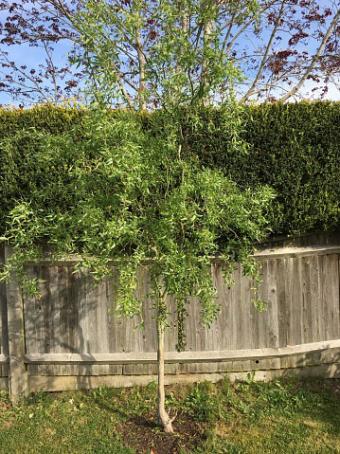
The corkscrew willow tree (Salix matsudana) is also known as the curly willow. It's part of the willow tree family and is often grown for its attractive fall foliage color, fast growing habit, and unique branching structure.
About the Corkscrew Willow Tree
The corkscrew willow tree earned its name thanks to its unique branching habit. As the tree grows, its branches reach out horizontally and then twist this way and that, creating curls or corkscrews. This gives the corkscrew willow four season interest in the home garden. In the spring, it has lovely buds. In the summer, its graceful leaves and fast growing habit provide shade. During the fall, the leaves turn a bright, almost pure yellow color before dropping to the ground. Winter allows the corkscrew willow's wonderful branches and intricate shapes to be seen against a backdrop of bright blue winter sky or white snow cover.
Size and Growth
Corkscrew willows are fast growing and reach a height of about 30 feet. Like other willows, they prefer moist soil. The roots stay shallow and near the surface, sometimes even pushing upwards as the tree ages. Keep this in mind when choosing a site to plant a corkscrew willow. These trees have been known to crack sidewalks and driveways or even break sewer and water lines with their roots. It's best to plant them far away from homes and other structures at risk from their roots.
As the branches grow, they tend to reach out horizontally. During winter months, snow and ice may crack and break branches on the tree. Sometimes corkscrew willows get blown down prematurely during strong winds because of both their shallow roots and their branching systems.
Care

Corkscrew willows are hardy from zones 4 through 8. It isn't particularly fussy about its soil and can grow equally as well in clay, loam or sand. It can grow in sunny or partly shady areas. Because it likes moisture, water this tree during periods of drought.
Pests
Gypsy moths remain a problem for the corkscrew willow. These moths appear as small caterpillar-like insects in the spring to early summer and eat the leaves of the tree. Most horticultural extension offices do not recommend sprays or other controls. Severe infestations of gypsy moths may be controlled by sticky bands placed around the trunk of the tree. As the young crawl up the trunk to reach the leaves, they're captured in the sticky tape and die. Aphids may lay eggs on the lower leaves but generally do not harm the tree.
Pros and Cons
There are several pros and cons to growing this tree in the home garden.
Reasons for Planting
On the plus side, its interesting branch structure, beautiful fall color and fast growing habits make it a desirable specimen tree. If you're designing a garden for four season interest, you can't go wrong with the corkscrew or curly willow, for its branches are dramatic and interesting when the leaves are gone. It is also good for areas where you want almost an instant tree since it grows to its mature height very quickly.
Downsides to the Tree
The downside to growing this tree is its short lifespan. Homeowners investing in their landscaping often want a tree that lasts for decades, not years. The tree tends to have a weak trunk and is prone to weather damage and cracking.
Popular Tree Choice
Because of its beautiful shape, unfussy nature and general disease resistance, this willow remains a popular choice among gardeners nationwide. Plant one and enjoy your new tree.







